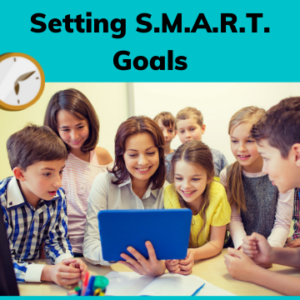In order to help kids succeed, we first need to help them figure out what they’re aiming for. Find out how you can empower your young learner to set SMART goals for success.

Think SMARTer: Helping Kids Set Goals For the Future
As adults, we tend to think that we always know what’s best for kids. This means that we usually decide what they should be doing, and how they should go about doing it. But is this really helping them to become independent, resilient learners?
When we set goals for our kids, we make choices based on our own knowledge and experience—not theirs. Instead, we should be teaching them how to create goals for themselves, so that they know how to build their own success from the start.
But as many of us know, setting goals is hard work. Most goals, if they’re not planned with intention, are simply doomed to fail. So where do we begin?
In order to make sure that our kids are able to follow through with their goals without giving up, we need to make sure that they know more than just where they’re going—they need to know how to get there, too.
One popular goal-setting framework is the acronym: S.M.A.R.T.
This framework takes you through each step of the goal-setting process, and it’s a simple way to break down the details of goal-setting in a way that kids can understand.
Essentially, “SMART” goals are Specific, Measurable, Achievable, Relatable, and Time-Based. If a goal meets each one of these criteria, it’s much more attainable—because it means that you’ve carefully considered every aspect of how you can succeed.
Let’s take a look at each of these five criteria, and how you can use them to help your kids learn to set SMART goals of their own.
Specific
When it comes to setting goals, we want to teach kids to be as specific as possible about what it is they want to achieve. Goals that are too general in how they’re defined become nearly impossible to achieve, because the path forward isn’t clear.
Think of it like climbing a mountain. Your ultimate goal may be to reach the top, but if you don’t plan a specific route—or even know which mountain you’re climbing—you’re likely to get lost in the wilderness, or to simply give up and turn back.
How to do it:
Broad, general goals are difficult to achieve because there are too many ways to define them. You can narrow down your goal into something specific by thinking of all the possible ways to define it—and then choosing the one with the best fit.
This might look like splitting one “big goal” into smaller, more specific chunks—and that’s okay! By focusing on one specific goal at a time, you’re still working toward achieving something bigger.
For example:
Ana has decided to dedicate her summer to helping the environment. That’s quite a tall order for one third-grader on summer vacation, so Ana’s mom helps her research some different ways of being eco-friendly: recycling, picking up litter, conserving electricity, and so on.
After some thought, Ana decides to start a neighborhood Clean Up Crew with her friends. Now, her goal is more specific: to get at least ten kids together every week to clean up litter from their community. Her broader goal of helping the environment is still intact, but now she has a specific place to start—and, at the end of the summer, she can set a new goal to start a recycling program at her school.
Measurable
If we can’t measure our progress, how can we know whether we’re really moving forward? Teaching kids to set measurable goals ensures that they can monitor their own progress, so that they can have complete autonomy over their success.
Measuring systems serve as motivational tools, as well. If we can’t see what progress we’ve already made, it’s easy to become discouraged and give up. But if we are able to visualize everything we’ve accomplished so far, success suddenly appears entirely within our reach.
How to do it:
Some goals may already have a measurement system in place; reading levels for reading-related goals, for example. Do some research to find out if someone has already created a system of monitoring growth in that area.
If your child’s goal doesn’t already have a measurement system in place, create one! Start by asking things like: “What are all the smaller steps you’ll need to complete in order to reach the end?” or “When we check in every week to see how you’re doing on this goal, what will we be looking for?”
For example:
Simon is in 4th grade, and has decided to write a fantasy novel similar to the ones he likes to read. But he starts feeling overwhelmed by such a big project, so his teacher helps him to break it into smaller pieces.
Now, Simon’s smart goal is to finish one chapter each week, and to have his teacher help him when he gets stuck. By measuring his goal in chapters rather than looking at the whole picture, Simon’s goal has become much more manageable.
Achievable
Of course, if you set a goal that is impossible—or nearly impossible—to achieve, you probably won’t get very far before giving up on it altogether.
And the same is true for anyone who believes that something is impossible, even if it’s not. This is the curse of a fixed mindset; if you don’t think you can do something, you’re absolutely right.
That’s why we need to help our kids learn to set goals that they believe they can achieve—and to turn the impossible into reality.
How to do it:
I believe that every goal is achievable with a growth mindset and some perseverance. In many cases, setting achievable goals is simply a matter of shifting your mindset!
With that said, some goals can feel overwhelming when you’re just getting started. Just as we did with “Specific,” try breaking larger goals into smaller pieces so that you can tackle each piece one at a time.
If you’re not sure how to break it down, try thinking: “What’s the next one thing I can accomplish that will get me closer to my ultimate goal?”
For example:
Leah is in 6th grade, and her lifelong dream is to become a film director in Hollywood. She knows that in order to make her dream a reality, she can attend a top film school in California after graduating high school. But that’s still a ways down the road, and Leah still wants to work toward her goal.
With help from some of her friends, she decides to write and direct her own film on the weekends using her smartphone. She reads books on filmmaking and finds tips online to help her make it as “real” as possible, and even learns how to use basic editing software on the computer. This way, Leah can start learning how to be a director right away, and begin building up a portfolio that she can eventually use to help her apply to her dream school.
Relevant
As adults, we often find ourselves setting goals for our kids that they ultimately struggle to meet. Why?
Usually it’s because we fail to ask whether the goals we’re setting for our kids are actually relevant to their lives. We might think so, as we can see how that goal might fit into the larger picture of their education, or for our plans for their future—but that relevance only matters to us.
If we want kids to set goals that they’ll be motivated to achieve, we need to ensure that those goals are relevant to them. Goals need to be meaningful to the person trying to achieve them; otherwise, at some point, they’re likely to give up in favor of something more interesting. And who can blame them?
How to do it:
To be sure that a goal is relevant to your kids, you first need to know what they find personally meaningful. The more they can connect with a goal, the more intrinsically motivated they will be to achieve it.
Start by noticing what gets them excited. What are they passionate about? What activities do they gravitate towards without prompting from an adult? What can they do interrupted for hours on end?
If you can help kids set goals that connect to their passions, they’ll be much more motivated to succeed.
For example:
Klaus’s teacher is worried that he is falling behind in reading compared to the rest of his classmates. She suggests that he makes it a goal to read one new book every week. He agrees, though he confesses that he doesn’t really like to spend time reading.
His teacher asks what he would rather be doing instead of reading. Klaus thinks for a moment, then says, “Minecraft. Or watching movies.”
The next day, Klaus’s teacher brings in a stack of books from the library for Klaus to choose from. Some are about Minecraft and movies, and others are fantasy stories with castles, villages, and medieval settings. “When you finish one of these books,” she tells him, “why not create the world of the story in Minecraft?” Now, Klaus’s goal has shifted to include the things he is passionate about, and he’s much more motivated to get started.
Time-Based
Time is an incredibly useful tool when it comes to planning and smart goal-setting. Often, we set goals with a deadline, or create a schedule to keep us on track. Why?
Because without some sort of structure holding our plans in place, they’re likely to get away from us. After all, the only thing that can truly defeat procrastination is a tight deadline!
How to do it:
In order to use time effectively as a goal-setting tool, we need to carefully consider how it already plays a part in our plans. How long will it take to complete each step of the process? Is there a specific date or deadline that the goal needs to meet? How much time do we have every day (or week, or month…) to work toward it?
For kids, and especially younger ones, thinking about goals in terms of time can be tricky. Time is an abstract concept, after all, and it can be difficult for kids to understand how much time an activity will take or to plan for a far-off future. You can provide additional support here, but be sure to allow kids some agency in the decision-making process; remember, it’s their goal!
For example:
Lily has made it her New Year’s Resolution to learn a new language. But time goes by, and she’s busy with other things. Around the second week of May, Lily remembers her goal—and realizes that she hasn’t even started working toward it yet!
She asks her parents for help, and together they make a plan that can work around her busy schedule. They decide that it doesn’t make much sense to put a deadline on learning a new language, since she can always improve. Instead, they add monthly progress checks to the family calendar to see how she’s improving. They also encourage Lily to practice speaking, reading, writing, and listening at least three times per week.
Setting smart goals can be a challenge—especially when you’re setting big goals for little kids. But by purposefully creating goals that are SMART, you can help teach kids not only to aim for high places, but to reach them.


